Explorations
Introduction
The explorations project was all about freedom. We chose a topic we wanted to learn more about, and had class time to learn and make a final product demonstrating our new knowledge. I loved this project, as it was an opportunity to explore a topic I likely would have never touched on, and gave me a further appreciation for the passions and works of other.
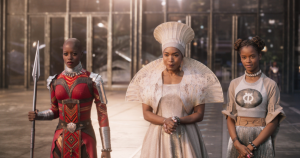
Costume Design by Ruth E. Carter for Black Panther
The topic I chose was costume design. I really love both film and theater, so this was something that bridged that gap, allowing me to learn about both, as costume design is very similar in both mediums. I work in tech theater, so I do know costume designers and work with them, but I never really learned everything they did and the work they put into it. I also love the details that go into work like costume, prop, and set design, so production design in general. Little details and tidbits make movies and plays so much more amazing. One of the amazing things I learned in my research was that in Black Panther, which won for best costume design at the 2019 oscars, was that in one scene, a choker that Shuri wears is made with special shells that used to be currency in Africa. This demonstrates that she is wealthy, while also keeping her design more modern. It was a detail no one really cared about when watching, but I loved it. It really showed the research and appreciation that went into the little things on costumes. I wanted to do that for my costume designs as well.
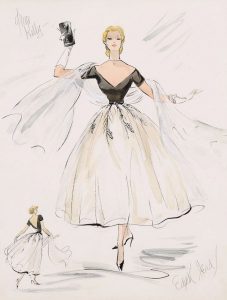
Costume Design by Edith Head for Rear Window
This project also taught me many 21st Century skills. I had to be very creative with the designs, particularly with the fantasy one. I had to self-direct in order to get the project finished on time. Collaboration was an interesting one that I wasn’t sure would come up, but surprisingly I worked very closely with a good friend of mine, Annabel Flint. She is an amazing artist who helped draw some sketches that looked a lot more similar to what I imagined than my sketches. She was also the consultant for the cultural design I made, as she is half-Japanese and was able to provide details and insights that I just could never get from some internet article.
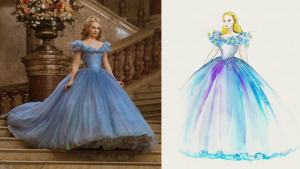
Costume Design by Sandy Powell for Cinderella
Process
The process of this project was really fun. Firstly, I had to research a lot of different designers and their process in creating costumes. Learning about how much designers do was crazy. They design for every part of a production, including for all the extras, in order for the world to be consistent. They also create a lot of the costumes themselves. They do hire a team to help them sew and create, but many of the costumes were bought, modified, and created by the designers themselves. This video I watched of Black Panther costume designer Ruth E. Carter enlightened me on a lot of the amazing details and work that goes into the job.
After I learned the process, I decided it was time to try it for myself. I picked three different genres to design for: Fantasy, Cultural, and Historical, going from easiest to hardest. Historical especially required a lot of research to understand the basics of fashion and clothing at that time for different genders, ages, and seasons. I know way too much about women’s clothing in the 1890s now. My favorite process was the cultural one. I decided to do something similar to Black Panther, but with a different cultural. I chose Japanese, as one of my best friends is half-Japanese and was happy to help me with details and advice that you just can’t get from an online article. Hearing about all the amazing details and touches that go into the clothing of a culture was really intriguing.
Product
In the end, I created three well-researched costume designs. The first one was a fantasy design for the character Piph from the play “Sunday Night” by Stephen Gregg. My wonderful friend Annabel Flint also helped create designs that has better proportions than mine, and generally better art that’s closer to what I imagined. Below you’ll see the sketch, line art, finished product, and Annabel’s interpretation (with better anatomy).
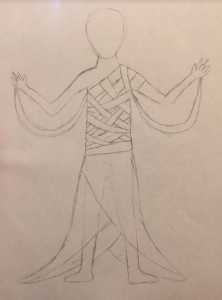
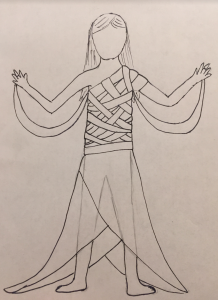
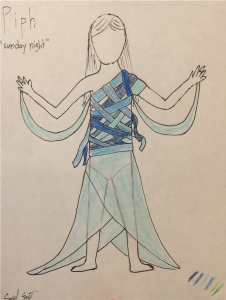
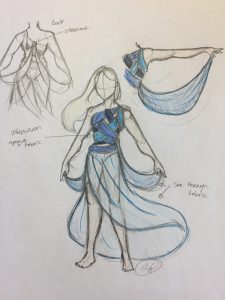
This one was the easiest to create, as it was fantasy and didn’t really have any guidelines or directions. I could do whatever I wanted, making this design a great first step into costume design. I read the entire play and took notes on Piph to be sure I understood her character and what she should be wearing. I really liked the light blue color, I thought it would blend in well with a forest-y background. I also looked into fabrics and thought about textures, wanting lighter and softer textures that didn’t weigh her down, as she is an ethereal saint-like being. I liked the shape of the dress being similar to flower petals, as Piph strikes me as a nature-like being. I also made it shorter in the front for better movement but longer in the back because a trail, at least a short one, made her more ethereal to me. Her top is the most striking feature of her design. I took this bandage dress top idea and made it a lot more extreme. I wanted it to look worn and hand-made, as Piph is an old creature, and one that is more spiritual. She wasn’t likely buying her clothes at H&M. The strings and ribbon design also represents how Piph is able to travel along her own time stream, or timeline. Piph has no shoes, because she seems like that kind of person.
My next design was for a cultural character, similar to Black Panther. The idea of mixing ancient culture with modern fashion and technology was super intriguing to me, and I wanted to try it for myself. I decided on Japanese culture, as my friend doing the drawings, Annabel, is half Japanese and was willing to share her culture with me. I think it’s very important to have someone actually from the culture talking to you about it. It feels cheap to just look it up, and you get details you wouldn’t have gotten from random history books. I based the character off Shuri and used that personality for my base. Annabel was given the honor of naming her, so here’s the design for Elise.
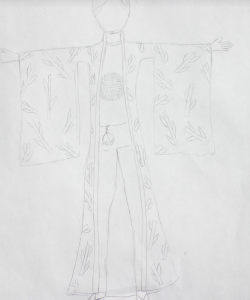
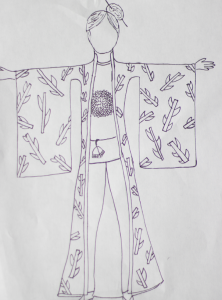
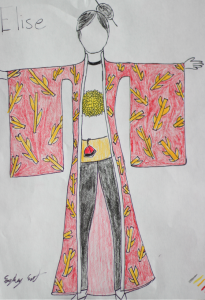
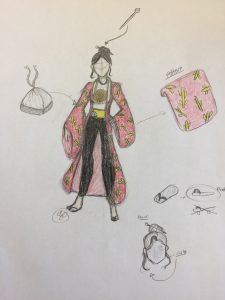
Elise was probably my favorite to design. Her statement piece is the coat she wears, which is based off of a Kimono. It has the box sleeves and the stiff collar, and the Obi, which is the large belt she has, contrasts the color of the kimono. Usually the obi is worn on the outside of the kimono, but we changed it up, making the kimono more like a coat and the obi more like a traditional belt of sorts. Her shirt has a chrysanthemum design on it. This is because the chrysanthemum is the symbol of the emperor in Japan, so if Elise was like a Japanese Shuri, she would likely be the emperor’s daughter. She has on black leggings, nothing special there, but her flip-flops are made of wood, reminiscent of the wooden shoes worn in Japan with kimonos. Though costume design doesn’t do hairstyles, they do have some influence on it, so I decided that she would have her hair up with a hair chopstick, keeping it away from her work. If you look at her obi, you can also see a bag hanging out of it. This bag is usually carried with Kimonos, and has a box-shaped bottom. Annabel mentioned how she would carry it in her belt, so we thought it would be a nice detail. For color, red seemed like the best idea. It’s a bright statement color for an outspoken and bright character. I accented that with gold.
The last design I did was the hardest. This was a historical design for the play “Yes, Virginia, There is a Santa Claus” by Jamie Gorski. This play took place in 1897, so I had to research what people wore at that time in the winter. It was a fun challenge, and I really enjoyed designing Virginia.
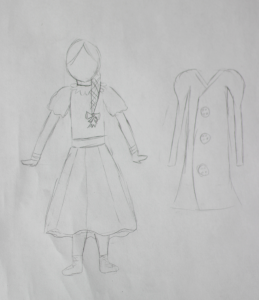
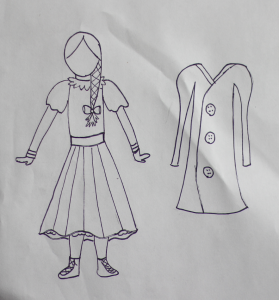
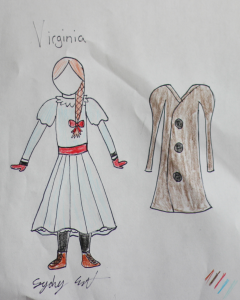
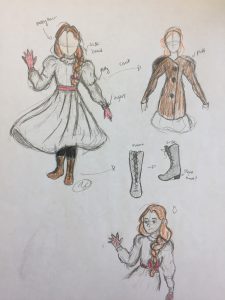
The most important thing I learned about women’s clothing at this time was that there were four main design aspects: big shoulders, cinched waist, bell skirt, tight sleeves. These four designs are seen throughout 1890s fashion, and so it was really important that my design reflected that. However, I did downplay them because Virginia is 8 years old. Children’s clothing had less craziness in the designs, and was more practical. The dresses were shorter and had less ruffles and poof. This also took place during the winter, so she would have a coat. The coats also had the large sleeves, and large buttons with a design that folded it over, seen in my drawing. I put the coat to the side so the whole outfit could be seen, as the coat isn’t on in every scene. I chose white-ish blue as the dress color, as white is an innocent color, and Virginia is an innocent girl. Red was the color I chose for the details like bows and gloves, as it stands out a lot. If I designed all the characters, I would avoid bright reds and whites on their outfits to make Virginia stand out the most. Her shoes are lace up boots, commonly worn at that time, and she has stockings under her dress, to keep her warm and modest. In was only in the 1920s that dresses became much shorter for adult women and the bottom halves of legs were able to be shown, but young girls still had shorter dresses, though they also had to cover their legs.
Those are all my designs! I could probably talk about each one even more than all I’ve already wrote, but I think I’ve bored you all enough.
Digital Media
In Digital Media, we created infographics to depict what we learned from our explorations project. I chose to show the steps of costume design in the movies, though it also applies to stage for the most part. Below that is my workspace. I used a ton of different shapes and different layers to make everything come together, which I showed in the screenshot.
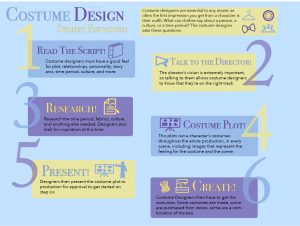
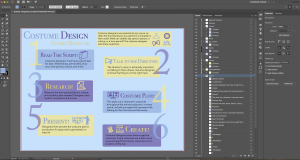
Music
Another activity we did in Digital Media was learning how to use Reason and ProTools, two music making softwares, and then making our own music with them. I’m not the most musical kind of person, but I really loved using all the different instruments that come with both programs. Playing a whole orchestra with only one mini piano hooked up to the computer is a good time. I decided to make a purely piano experimental song, as I really enjoy how pianos sound and I loved playing it on protools. It’s a short song, but I like how it sounds. I named it Soothe, and created some art for it as well. Please enjoy Soothe.
Here is my album art as well as my ProTools workspace, which I used to create the song.
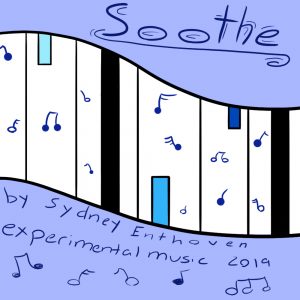
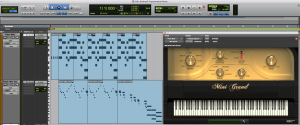
Final Presentation
All my hard work and research cultivated into a final presentation to all the freestyle juniors, which can be seen below:
ARVE Error: src mismatchprovider: youtube
url: https://www.youtube.com/watch?v=KRCnTJXPsMk&list=PL4UmbWlij-uS97TD73MQzSo8FprBKAj_b&index=11&t=0s
src in org: https://www.youtube.com/embed/KRCnTJXPsMk?list=PL4UmbWlij-uS97TD73MQzSo8FprBKAj_b
src gen org: https://www.youtube.com/embed/KRCnTJXPsMk?start=0&list=PL4UmbWlij-uS97TD73MQzSo8FprBKAj_b
I was very nervous for this performance, but I completed it all just barely on time. I was frustrated by this presentation because I felt like I couldn’t say everything I wanted to. Each costume had special details that I loved but I couldn’t explain due to the strict time limit. However, I hope my project was enticing enough that even one or two of my peers to check out my more detailed explanation here on my website. Though I don’t have a PDF of the exact slides, as mine had animations in them that don’t translate to PDF, I do have them pretty much the same right here:
SydneyE-Explorations Presentation PDF
Reflection
I valued the freedom of this project. I could learn about any skill and explore anything. I didn’t ever have to use this information again, I could just investigate a skill I wanted to know more about and use the time I had to do something new and exciting. I really benefited from this project, as it gave me the chance to learn about something I doubt I ever would have researched ever in my life. I knew nothing about fabrics, costume designers, historical fashion trends, Japanese culture, any of that. But this project allowed me to explore all that and more, including character design, character study, production design, and the work every single person on a film set puts into their job to create the world we know and love. I also learned so much about music production and design in digital media, letting me learn about another skill I never would have looked into on my own.